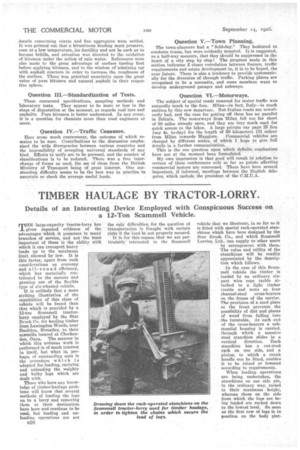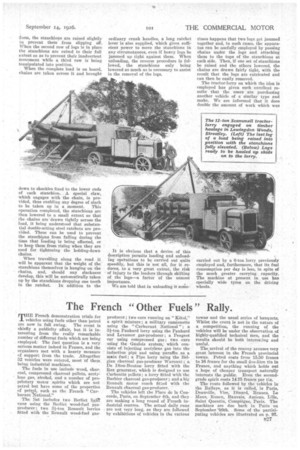TIMBER HAULAGE BY TRACTOR-LORRY.
Page 44

Page 45

If you've noticed an error in this article please click here to report it so we can fix it.
Details of an Interesting Device Employed with Conspicuous Success on a 12-Ton Scarnmell Vehicle.
TIIN large-capacity tractor-lorry has given repeated evidence of the advantages which it possesses in many branches of service, and not ,the
loads up to the maximum limit allowed by lawIt is this factor, apart from such considerations as economy and all-round efficiency, which has materially contributed to the success and growing use of the flexible type of six-wheeled vehicle. It is unlikely that a more striking illustration of the capabilities of this class of vehicle will be found than that which is provided by a 12-ton Scammell tractorlorry employed by the Star Brush Co. for hauling timber from Lewingdon Woods, near Basildon, Streatley, to their sawmills located at Checkendon, Oxon. The manner in which this arduous work is performed is of much interest in itself, but what is, perhaps, of outstanding note is the procedure which is adopted for loading, carrying and unloading the weighty and bulky logs which are dealt with.
Those who have any knowledge of timber-haulage problems will know that several methods of loading the logs on to a lorry and removing them at their destination have been and continue to be used, but loading and unloading operations are not B26 the Only difficulties, for the question of transfiortation is fraught With certain risks if the load be not properly secured.
It is for this reason that we are particubirly interested in the Scammell vehicle that we illustrate, in so far as it is fitted with special rack-operated stanchions which have been designed by the Star Brush Co., and which Scammell Lorries, Ltd., can supply to other users by arrangement with them. The value and utility of the stanchions will be readily appreciated by the description which follows.
In the case of this Scammell vehicle the timber is loaded by an ordinary sixpart wire rope tackle attached to a light timber trestle and rests on four channel-steel cross-bearers on the frame of the carrier. The provision of a steel plate at the front prevents the possibility of dirt and pieces of wood from falling into -the turntable. At each end of the cross-bearers a substantial housing is carried, through which a massive steel stanchion elides in a vertical direction. Each stanchion has a cut-steel rack on one side, and a pinion, to which a crank handle can be fitted, enables it to be raised or lowered according to requirements.
When loading operations are being undertaken, the stanchions on one side are, in the ordinary way, raised to their maximum height, whereas those on the side from which the logo are being loaded are racked down to the lowest level. So soon as the first row of logs is in vosition on the body plat form, the stanchions are raised slightly tq prevent them from slipping off. When the second row of logs is in place the stanchions are raised to their full extent so as to prevent their inadvertent movement while a third row iS being manipulated into position.
When the complete load is on board, chains are taken across it and brought down to shackles fixed to the lower ends of each stanchion. A special claw, which engages with the chain, is provided, thus enabling any degree of slack to be taken up in a moment. This operation completed, the stanchions arc then lowered to a small extent so that the chains are drawntightly across the load, it being understood that substantial double-acting steel ratchets are provided. These can be used to prevent the stanchipns from falling during the time that loading is being effected, or to keep them from rising when they are used for tightening the holding-down chains.
When travelling along the road it will be apparent that the weight of the stanchions themselves is hanging on the chains, and, should any slackness develop, this will be automatically taken up by the stanchions dropping one tooth in the ratchet. In addition to the ordinary crank handles, a long ratchet lever is also supplied, which gives sufficient power to move the stanchions in any circumstances, even if heavy logs be jammed up tight against them. When unloading, the reverse procedure is followed, the stanchions only being lowered as much as is necessary to assist in the removal of the logs.
It is obvious that a device of this description permits loading and unloading operations to be carried out quite speedily, but this is not all, for it reduces, to a very great extent, the risk of injury to the loaders through shifting of the logs—a factor of the utmost importance.
We are told that in unloading it some
times happens that two logs get jammed together and, in such cases, the apparatus can be usefully employed by passing chains under the logs and attaching them to the tops of the stanchions at each side. Then, if one set of stanchions be raised and the others lowered, the chains are drawn fairly tight, with the result that the logs are extricated and can then be easily removed.
The tractor-lorry on which the idea is employed has given such excellent results that the users are purchasing another vehicle of a similar type and make We are informed that it does double the amount of work which was
carried out by a 0-ton lorry previously enaployed and, furthermore, that its fuel consumption per day is less, in spite of the much greater carrying capacity. The machine at present in use has specially wide tyres on the driving wheels.




































































































